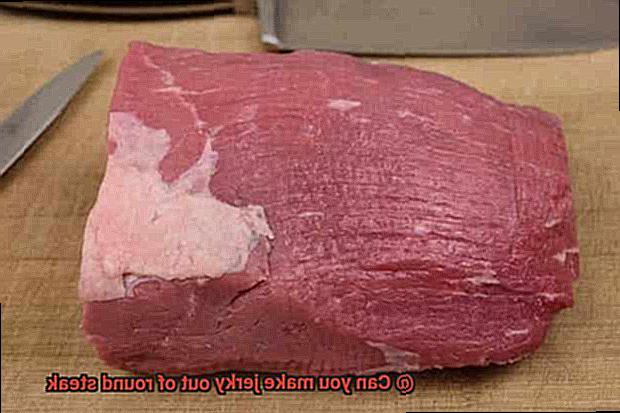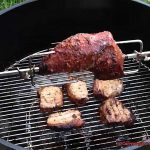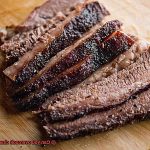Are you a beef jerky fanatic in search of your next flavourful fix? Maybe you’ve got some round steak tucked away in your freezer, but you’re not sure if it’s up to snuff for jerky-making. Well, fear not. We’ve got the answers to your burning question: Can you make jerky out of round steak?
- Let’s address the elephant in the room – round steak isn’t exactly a top-tier choice for making jerky. But that doesn’t mean it can’t be done. In fact, there are some advantages to using this cut over pricier options like sirloin or flank steak.
- But here’s the catch – creating a mouth-watering batch of round steak jerky requires some know-how. You’ll need to follow specific preparation techniques and use the right seasonings to ensure your meat is both flavourful and safe to consume. Luckily, we’re here to guide you through every step of the process.
Whether you’re an experienced jerky-maker or just starting out with round steak, we’ve got all the tips and tricks you need to succeed. So let’s dive into the world of round steak jerky and discover how to make this underrated cut shine.
Contents
What is Round Steak?
This lean cut of beef is sourced from the hindquarters of the cow, specifically the round, which is the rear end. Due to its low fat content and muscle fibers, round steak is typically less tender than other cuts. However, this doesn’t mean it’s not delicious. In fact, round steak comes in various forms, including top round, bottom round, and eye of round. Each type has its own unique qualities and uses.
Top round steak is the most tender among the three and can be used for roast beef or sliced for sandwiches. On the other hand, bottom round steak is leaner and less tender than top round but still has a great flavor. Lastly, eye of round steak is the least tender and requires slow-cooking methods like braising or roasting.
One popular use of round steak is for making jerky. The meat’s meaty flavor and high protein content make it an excellent choice for this snack. To make jerky out of round steak, it’s essential to slice the meat thinly against the grain. This technique breaks down the connective tissue in the meat and makes it easier to chew.
Before slicing the meat, it’s crucial to remove any excess fat or connective tissue using a sharp knife or a meat slicer. Afterward, you can season the meat with a variety of spices and marinades such as soy sauce, Worcestershire sauce, garlic powder, onion powder, or black pepper.
To ensure that the flavors infuse into the meat and also help tenderize it, you should marinate it for at least a few hours or overnight. Once done marinating, you can proceed to dehydrate it on a dehydrator or oven at low temperature (around 150-170 degrees Fahrenheit) until fully dried out.
Benefits of Making Jerky Out of Round Steak
Take your jerky game to the next level with round steak. As an expert on the benefits of using this cut of meat for jerky-making, I can confirm that it offers a range of advantages that make it the perfect choice for your next batch of homemade jerky.
Firstly, round steak is a lean cut of meat, making it ideal for making jerky. It has less fat than other cuts, which means that it won’t go rancid during the drying process and spoil the flavor and texture of your jerky. With round steak, you can be sure that your jerky will be both lean and delicious.
Not only is round steak lean, but it’s also an affordable option for those on a budget. Compared to pricier cuts like sirloin or ribeye, round steak won’t break the bank. You can enjoy delicious and flavorful jerky without breaking the bank.
Round steak is also incredibly versatile. You can easily flavor it with different spices and marinades to create a wide variety of unique and delicious jerky flavors. Whether you prefer sweet and spicy or savory and smoky, round steak can take on any flavor profile you desire.
Finally, slicing round steak into thin strips is a breeze. It has a natural grain that makes it easy to slice against for tender and chewy jerky every time. No more struggling with tough cuts or uneven slices – round steak makes homemade jerky-making a breeze.
Preparing the Meat for Jerky
Although leaner than other cuts of beef, it is still an excellent choice for creating scrumptious and flavorful jerky. As an expert on the subject, I have compiled some research notes to guide you through the process of preparing round steak for jerky.
Choosing the right cut of meat is crucial for successful jerky-making. For round steak, look for uniform thickness and make sure there is no visible fat or gristle. If uncertain, consult your local butcher for advice.
Once you have your round steak, it’s time to prepare it for the dehydrator. Start by trimming away any excess fat or connective tissue as fat can become rancid during the drying process. Then, slice the meat against the grain into thin strips. Cutting against the grain breaks down muscle fibers, resulting in more tender jerky. Aim for around 1/4 inch thick strips.
Now comes the fun part – marinating. Unleash your creativity and experiment with different flavors and spices. A good marinade not only adds flavor but also helps tenderize the meat. Let your meat marinate for several hours or even overnight.
When it’s time to dry out your jerky, using a dehydrator is one of the most popular methods. Arrange your meat strips on the dehydrator trays, leaving plenty of space between each strip to allow for air circulation. Set your dehydrator to around 160°F and let it run for several hours until the jerky is dry but still pliable.
Once your jerky is done, let it cool to room temperature before storing it in an airtight container. Properly dried and stored jerky can last for several weeks at room temperature or even longer if kept in the fridge or freezer.
Marinating the Meat
Then, let’s dive into the art of marinating the meat. As an expert in this field, I can tell you that a good marinade is the key to achieving tender, juicy, and flavorful jerky. Here are some tips on how to do it right:
First and foremost, choose a cut of round steak. It’s lean, affordable, and easy to work with. Trim any excess fat and slice the meat thinly against the grain. This will create shorter muscle fibers, which translates to more tender jerky.
Now, let’s talk about the marinade. A marinade typically consists of four components: acid, salt, sweetener, and seasonings. Acidic ingredients like vinegar, citrus juice, or wine help to break down the tough fibers in the meat and add tanginess to the flavor profile.
Salt not only enhances the taste but also draws out moisture from the meat, which aids in preservation. Sweeteners such as honey, brown sugar, or maple syrup balance out the acidity and bring a touch of sweetness to the mix. Finally, seasonings such as garlic powder, onion powder, cumin or paprika add depth and complexity to the overall taste.
To marinate the meat correctly, place it in a large ziplock bag or a shallow container with the marinade. Make sure that all the meat is fully coated with the mixture. Then refrigerate it for at least 8 hours or overnight. This allows enough time for the acid to work its magic and tenderize the meat properly.
When you’re ready to dehydrate your jerky, remove the meat from the marinade and discard any excess liquid. Pat dry with paper towels and place it on your dehydrator trays. Follow your dehydrator’s instructions for drying time and temperature.
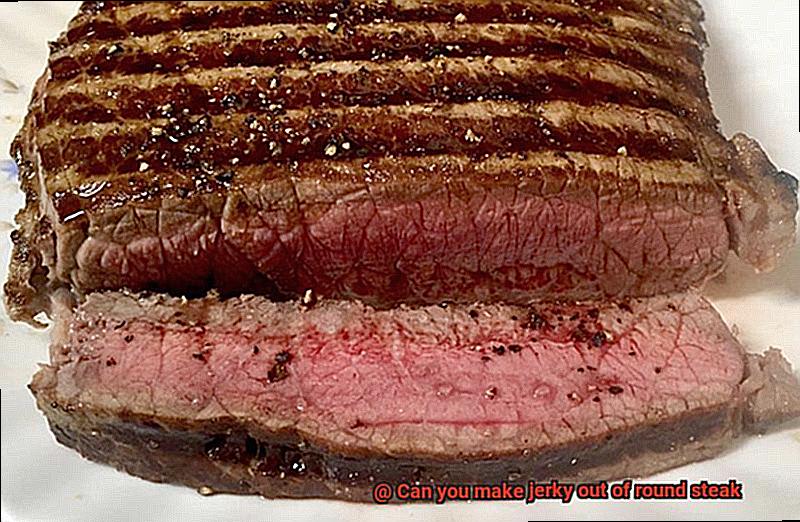
Dehydrating the Meat
Dehydrating the meat is an art that requires attention to detail. It is an essential step in creating the perfect texture and flavor of jerky. The process involves removing moisture from the meat, making it less prone to spoilage and creating a chewy texture that is characteristic of jerky.
To make jerky, you need to slice your round steak into thin strips against the grain, which helps break down the muscle fibers and makes the jerky easier to chew. Additionally, removing excess fat from the meat is crucial as it can go rancid during the dehydrating process.
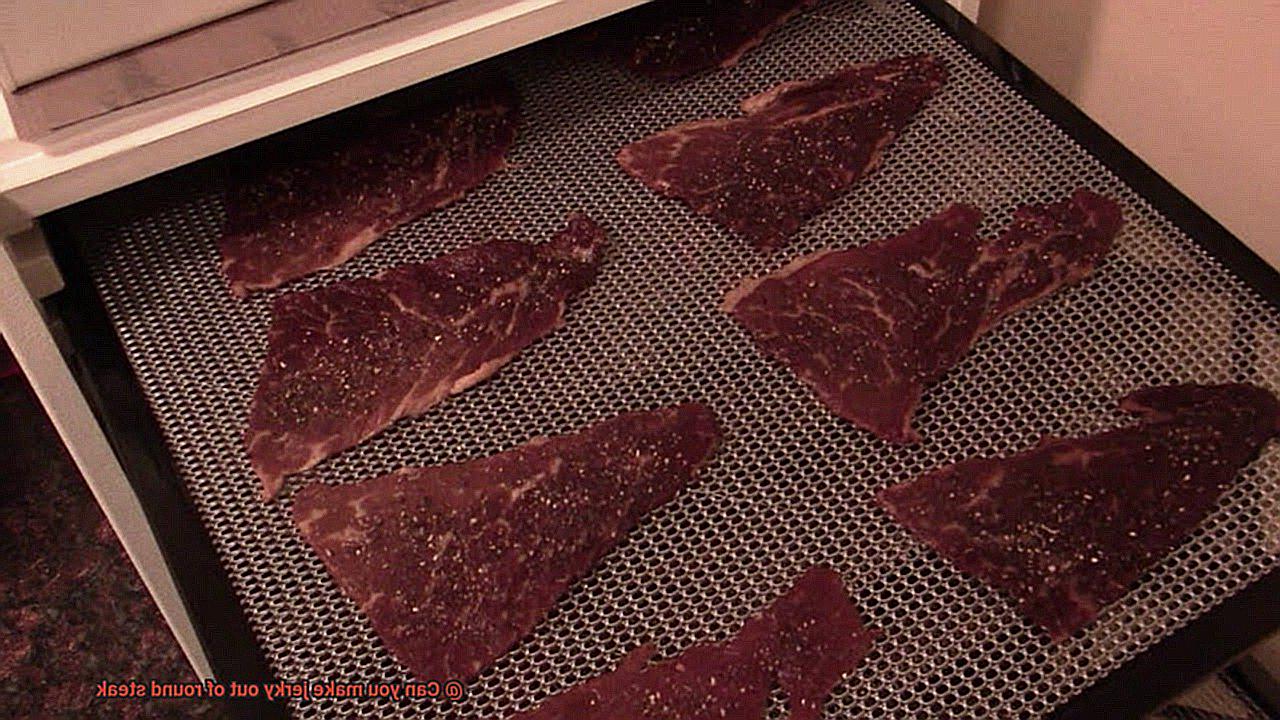
Now comes the exciting part – dehydrating your meat. There are several ways to do this, including using a dehydrator or an oven. If you have a dehydrator, all you need to do is place the strips of meat on the trays and set the temperature according to the manufacturer’s instructions. It usually takes around 6-8 hours for the meat to fully dehydrate.
If you don’t have a dehydrator, don’t worry. You can still achieve great results using your oven. Preheat it to 160-170°F (71-77°C) and place the strips of meat on wire racks over a baking sheet. Leave the oven door slightly open to allow for air circulation and check on the meat every hour or so, flipping the strips over to ensure even dehydration.
It’s important to note that dehydrating times may vary depending on factors such as humidity, thickness of the meat, and temperature of the dehydrator or oven. So, keep an eye on your jerky and look for a consistent color throughout each strip and a firm texture that bends without breaking.
Once your jerky is fully dehydrated, let it cool completely before storing it in an airtight container or plastic bag. Properly stored jerky can last for several weeks or even months, making it a convenient snack for outdoor activities or on-the-go snacking.
Flavoring the Meat
In this guide, we’ll explore the many ways to add mouth-watering flavors to your round steak jerky.
Let’s start with marinades. A good marinade can transform a simple piece of meat into a delectable and savory snack. Soy sauce, Worcestershire sauce, and vinegar are just some of the ingredients that can be mixed with spices to create a tasty and unique marinade for your jerky. Soaking the meat in this mixture for several hours or overnight allows the flavors to penetrate the meat fully, resulting in juicy and flavorful jerky.
But if you’re looking for more control over your flavor profile, a dry rub might be the way to go. A mixture of spices and herbs is rubbed onto the surface of the meat before dehydration, allowing for more customization to your personal taste preferences. You can experiment with different combinations of spices to create your own signature dry rub.
Sweet tooths rejoice. Brown sugar or honey can be added to both marinades and dry rubs for a deliciously sweet and savory jerky. For those who crave heat, cayenne pepper or chili powder will add a fiery kick to your snack. But be warned: spicy ingredients should be used sparingly and adjusted according to your personal tolerance for heat.
To ensure that your jerky is bursting with flavor, it’s important to make sure that each piece of meat is evenly coated with your chosen flavoring method before dehydration. This will guarantee that every bite is consistently delicious.
Different Cuts of Round Steak Suitable for Jerky
Selecting the right cut of meat is crucial to making delicious jerky, and the round steak is an excellent choice due to its lean and flavorful qualities.
The two most common cuts used for jerky are the top and bottom round. The top round is ideal because of its leaner composition with little marbling, making it a popular choice for jerky enthusiasts. It’s also more tender than the bottom round, which is why it’s often preferred. However, don’t disregard the bottom round, which may be tougher but has a unique flavor and texture that some people prefer.
If you’re feeling adventurous, you can try using the eye of round. This cut comes from the center of the round and is even leaner than the top round. It’s also one of the most tender cuts of round steak, making it perfect for creating a delicious jerky.
When preparing your meat for jerky, it’s crucial to trim away any excess fat or connective tissue before slicing and seasoning. This will ensure that your jerky has a longer shelf life and stays fresh and tasty.
Tips and Tricks for Making Delicious Jerky from Round Steak
Jerky is a beloved snack that’s perfect for people on the go or those who want to munch on something flavorful and high in protein. When it comes to making jerky from round steak, there are a few tips and tricks that can help you create a delicious, tender, and flavorful snack.
Select the Right Cut of Meat
The first step in making delicious jerky from round steak is selecting the right cut. Round steak is a popular choice because it’s lean and has a uniform texture. This makes it ideal for jerky because it’s easy to slice and dehydrate without any spoilage. If possible, choose grass-fed beef that’s free from hormones and antibiotics for an even healthier snack.
Slice Against the Grain
Once you have the right cut of meat, it’s time to slice it thinly against the grain. This helps to break down the muscle fibers and make the jerky more tender. Use a sharp knife or a meat slicer to achieve even slices that are around 1/8 to 1/4 inch thick. Slicing against the grain creates shorter fibers, which makes the jerky easier to chew.
Marinate for Flavor and Tenderness
The next step is marinating the meat in a flavorful mixture. A good marinade will not only add flavor but also help tenderize the meat. Some popular marinade ingredients include soy sauce, Worcestershire sauce, honey, garlic, and onion powder. You can experiment with different combinations of ingredients until you find the perfect flavor profile.
Monitor Temperature Closely
When it’s time to dehydrate the meat, it’s important to monitor the temperature closely to ensure that the jerky dries evenly and doesn’t become overcooked. Whether you’re using a dehydrator or an oven set on a low temperature, check the jerky frequently as it dries out. Over-drying can result in a tough, chewy texture that’s not very enjoyable.
Store Properly for Freshness
Proper storage is key to maintaining the freshness and flavor of your jerky. Once it’s fully dehydrated, let the jerky cool completely before storing it in an airtight container or bag. You can store it at room temperature for several weeks or in the refrigerator for even longer. Jerky can also be frozen for extended storage, but be sure to thaw it slowly to avoid any unwanted texture changes.
Conclusion
To sum up, crafting jerky from round steak is a feasible and budget-friendly option for those who love this tasty snack. Despite not being the most tender cut of beef, round steak presents several advantages, such as its leanness and adaptability to various flavors. Achieving delectable round steak jerky involves slicing the meat thinly against the grain, eliminating excess fat or connective tissue, and marinating it for several hours or overnight. To obtain the ideal texture and taste, dehydrate the meat at a low temperature until completely dry.
For making jerky with round steak, opt for top or bottom round cuts due to their lean composition and tenderness. Nonetheless, if you’re looking for a more distinctive flavor and texture, eye of round can also be used. Properly storing your homemade jerky in an airtight container or bag at room temperature or in the fridge can prolong its shelf life by weeks or even months.
By following these tips and tricks, you’ll be able to concoct mouth-watering and flavorful round steak jerky that will satiate your hunger pangs anytime, anywhere.

